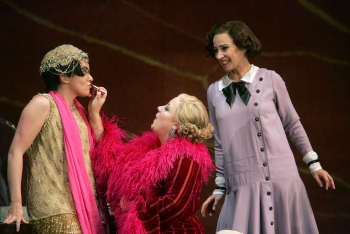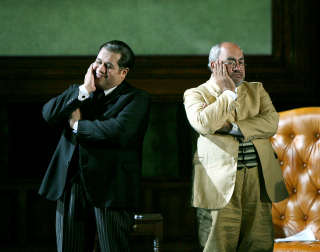|
Editorial Board
Melanie
Eskenazi
Webmaster: Len Mullenger
|
Seen and Heard Opera Review
Mozart, The Marriage of Figaro: Soloists, chorus & orchestra of English National Opera/Roland Boër. London Coliseum, Thursday, 2.11.2006 (CC)
Victoria Simmonds (Cherubino) Lisa Milne
(Countess Almaviva) Marie Arnet (Susanna)
Interventionist production was apparent straight away
as a gardener ‘watered’ fake pink flowers as the orchestra
tuned. The stage furniture also told of the master/servant
divide, with bells for each room so the lackeys could
be summoned by the gentry at any time. The stage was set
for some fizzing action. The use of space as the opera
progressed was impressive, with the stage being divided
expertly. A pity, then, that the conductor (and fortepianist)
Roland Böer’s tempi frequently appeared just under the
tempo giusto, often robbing the music of its intrinsic
vivacity. ‘Se vuol ballare’ was a perfect case in point
on an aria level; on a larger, more structural level,
long portions of Act 2 in particular suffered. Ensemble,
too, could stray (particularly in Act 4, but there were
examples in each act). Jonathan
Lemalu (Figaro), Jonathan Veira (Dr Bartolo)
Yet to balance all this there was plenty to admire. The idea of recitatives
accompanied by fortepiano is one that always appeals – and not just because I
love the sound of that instrument! The fortepiano’s tone carries to the furthest
reaches of the opera house and its dynamic range seems ideally suited. The cast
had much to recommend it. (Bear in mind that this is the ‘first’ cast – in the
New Year the principals will change.) Jonathan Lemalu’s Figaro stole the show.
Lemalu is a first-rate bass-baritone and his vocal command was stunning
throughout. He acts well, too, and certainly made a superb team with his
betrothed, Marie Arnet’s Susanna. What impressed was his diction and his real
assimilation of his character – his ‘Military’ aria was absolutely superb. As
for Arnet, there have been more coquettish Susannas than this, but Arnet chose
to underline her character’s humanity; the Figaro/Susanna duets were always pure
joy.
Victoria Simmonds took the role of Cherubino (here in bell-boy costume). Her
‘Non so piů’ sat in the inevitable shadow of Koženŕ, so recently heard at the
Barbican, and Simmonds’ take was nowhere near as virtuosically breathless as
her more famous colleague’s. But Simmonds has real talent, that much is certain.
The Count and Countess were Mark Stone and Lisa Milne. Mark Stone impressed
greatly as the Don in the 2004 Giovanni (see
review). The Count seemed less his thing, though, although this particular
Count was certainly a master of smarm (shades of the Giovanni?). Lisa
Milne has greatly impressed in the past, but her Countess was rather warbly,
especially in ‘Porgi amor’ – or here, ‘Hear my prayer’; ‘Dove sono’ was
similarly less than 100% steady.
Of the smaller parts, Jonathan Veira was a slightly weak Basilio (looking a bit
like Bernard Cribbins, I thought!) while Claire Debono was a delightfully cheeky
Barbarina. Debono appears to be something of an early music specialist, going on
her biography, and her light but confident voice shone when given the chance.
The experienced hands of Graeme Danby (the gardener, Antonio) and Diana Montague
as Marzellina provided a reminder of just how strong a company ENO really is.
So, definitely one to catch. I just wonder how resilient the production actually
is, for all its cleverness. The relocation of the action makes another link, in
addition to the gentry/servant one already explored: the feel of a comedy of
manners, indeed at times of slapstick, moves the opera in the direction of
Gilbert and Sullivan, something English National Opera are famously good at.
Colin
Clarke
Pictures © English National Opera / Alastair Muir
2006 Back to the Top Back to the Index Page |
| ||
|
||||




